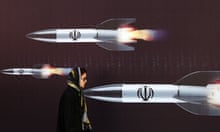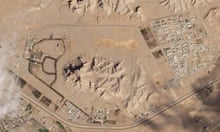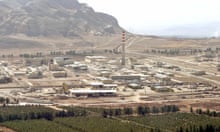While the details remain vague, and Iranian denials strong, it seems very likely, given past history and strong comments from US officials, that a limited Israeli drone strike was launched against the Iranian city of Isfahan on Friday morning.
Isfahan is significant for its military-industrial facilities, the presence of an important facility in Iran’s nuclear programme and a major airbase hosting the Islamic Republic’s ageing fleet of F-14 “Tomcats”, making the importance of any strike, whether carried out from beyond Iran’s borders or from within but backed by Israel, more than symbolic.
While Israel has long been engaged in a “shadow war” with Iran – including a claimed Israeli drone strike on a weapons production facility in Isfahan just over a year ago – the dynamics of conflict are defined as much by the context in which events happen as the discrete fact of the attacks themselves.
What is new and dangerous, regardless of the scale or the suspicion of a degree of posturing on both sides, is that a new normal is establishing itself in the conflict between Iran and Israel.
Iran’s attack on Israel last weekend, in response to Israel’s strike on one of Tehran’s diplomatic facilities in Syria, happened in the open, the first strike on Israel soil by a foreign state in more than three decades.
Israel’s response, if it is limited only to this, and despite the radio silence from official sources, no longer exists inside some grey area of somewhat implausible deniability.
And while it is far from the first time that Israel has sought to hit Iran and Iranian interests in a campaign of assassinations, drone strikes and sabotage, this time it has occurred in the midst of a period of intensive scrutiny.
If, as an unnamed Israeli source told the Washington Post, the strike “was intended to signal to Iran that Israel had the ability to strike inside the country”, that message will not have been lost on an Iran that has already felt compelled to act because of its concern that its policy of deterring Israel has been undermined.
The reality is that the rules of confrontation that have long existed between Iran and Israel, in a conflict fought first through proxies and now ever more directly, have been torn up in the six months since Hamas (a recipient of Iranian support) launched its surprise attack on southern Israel on 7 October last year.
In those six months, what was once seen as given has unravelled. In Gaza, a war unprecedented in its violence and protracted nature has ground on. On the shared border between Israel and Lebanon, another conflict has confounded the normal rules, with the exchanges of fire with Hezbollah – another Iranian proxy – that began on 8 October now a daily reality that has displaced tens of thousands of people on both sides of the border.
Now a new threshold has been crossed, a boundary of mutual fear and restraint. And while many analysts and officials have been quick to suggest that a limited Israeli strike on Iran could mean a return to the status quo ante, another and more worrying possibility is that this merely signals that this widening conflict has become more dynamic.
If Israel made serious intelligence errors in the past six months – both over Hamas’s aggressive posture before 7 October and in miscalculating how Iran would respond to the 1 April strike on Damascus – it is worth recalling that the same institutions and many of the same individuals, driven by the same assumptions, will be processing the potential danger of the most recent events.
Politically, it is hard to see how such a limited response by Israel benefits Benjamin Netanyahu. For a figure who has been so long and so profoundly linked to a hawkish position on the threat posed by Iran and its nuclear programme, an Israeli strike that is so limited in this context will be seen by many not as a sign of boldness and resolve, as Netanyahu would like it, but of weakness.
Already Netanyahu’s far-right coalition ally and national security minister, Itamar Ben-Gvir, who is eyeing votes from the right within Netanyahu’s Likud party, has said as much on X, suggesting it was too limited a response with a single word: “Feeble!”
While on the Iranian side the initial noises suggest it hopes to characterise what occurred on Friday as insufficiently serious to warrant a response, the same calculations that led it to launch 300 missiles and drones towards Israel last weekend still hold true.
What is clear is that both sides are playing with fire.








